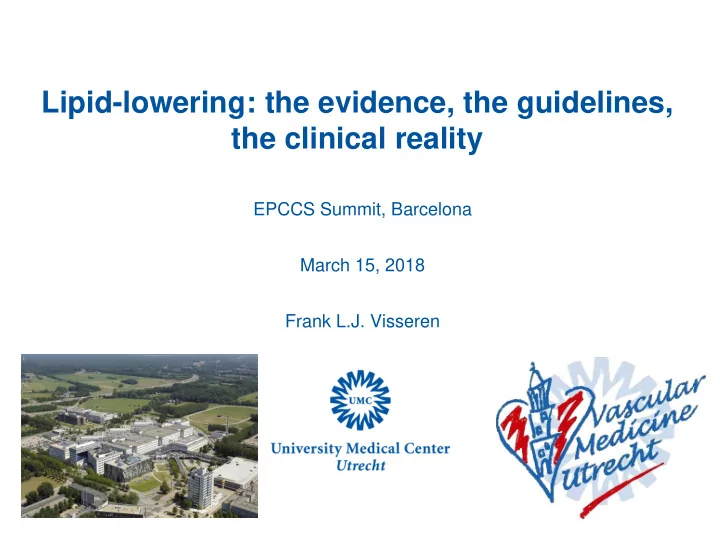

Lipid-lowering: the evidence, the guidelines, the clinical reality EPCCS Summit, Barcelona March 15, 2018 Frank L.J. Visseren
State of the Union 2015: “Precision medicine gives us one of the greatest opportunities for new medical breakthroughs that we have ever seen…” “…delivering the right treatments, at the right time, every time to the right person …” “…the possibility of applying medicines more efficiently and more effectively so that the success rates are higher…” “…a new wave of advances just like genetics 25 years ago…”
State of the Union 2015: “…what we want is that we can make better life decisions and making sure that we’ve got a system that focuses on prevention and keeping healthy, not just on curing diseases after they happen.” “…I’m asking researchers to join us in this effort. And I’m asking entrepreneurs and non-profits to help us create tools that give patients the chance to get involved as well .”
Greatest challenge for a clinician Translating the results of (large) randomized clinical trials to treatment of individual patients
I. Lipid-lowering: the evidence • Lipids are (the most) important CV risk factor • Overwhelming evidence • The lower LDL-c, the lower CV risk
Most important risk factors for MI (INTERHEART study) Riskfactor Gender Smoking F M Diabetes F M Hypertension F M patients: 15.152 Abdominal obesity F controls: 14.820 M 52 countries Psychosocial index F M ORs adjusted for: Fruit/vegetables F age M gender Physical activity F geographic region M Alcohol F M LDL/HDL-ratio F M 0.25 0.5 1 2 4 8 16 Odds ratio (99% CI) Yusuf S et al. Lancet. 2004;364:937-52.
CTT meta-analysis 1 mmol/l ↓ LDL -c = 21% ↓ CV risk Lancet 2015;385:1397-1405
Lower LDL-c is better in CV patients TNT IDEAL N Engl J Med 2005;352:1425-35. JAMA 2005;294:2437-45.
PCSK9-i in CV patients on top of standard of care lipid-lowering NEJM 2017;376:1713-1722
LDL-c reduction and CV risk reduction by various lipid-lowering strategies Eur Heart J 2017; Aug 14 epub
II. Lipid-lowering: the guidelines • ESC guidelines on CV prevention in clinical practice • National guidelines • What to do with elderly persons/patients?
Risk categories
1 Treatment goals for low-density 5 lipoprotein-cholesterol
Pharmacological treatment of hypercholesterolaemia
All elderly at very high risk???
problem OK problem
CV risk in elderly (patients) without vascular disease Clin Res in Cardiol. 2017 Jan;106(1):58-68
Lipid-lowering in elderly and risk of myocardial infarction On average 20% CV risk reduction by lipid-lowering in elderly
CV risk in elderly (patients) without vascular disease Clin Res in Cardiol. 2017 Jan;106(1):58-68
CV risk in elderly patients with vascular disease Clin Res in Cardiol. 2017 Jan;106(1):58-68
Risk categories (proposal!)
III. Lipid-lowering: the clinical reality Reaching LDL-c treatment goals is a problem Adherence to statins is a problem How to deal with statin intolerance? Statins in the media Shared decision making by individualized risk estimation and risk prediction
Statin adherence in CAD patients in Europe: (EUROASPIRE-4) Voorspellen van het risico op Atherosclerosis 2016;246:243-250
Proportion of CAD patients at LDL-c goal (EUROASPIRE-4) Voorspellen van het risico op Atherosclerosis 2016;246:243-250
After discontinuation, re-starting a statin usually is successful! Ann Intern Med 2013;158:526-534
After discontinuation, re-starting a statin usually is successful! Ann Intern Med 2013;158:526-534
After discontinuation, re-starting a statin usually is successful! Ann Intern Med 2013;158:526-534
After discontinuation, re-starting a statin usually is successful! Ann Intern Med 2013;158:526-534
After discontinuation, re-starting a statin usually is successful! Ann Intern Med 2013;158:526-534
Media Voorspellen van het risico op
Media
Statin-related news stories and cessation of statins and risk of CV events Voorspellen van het risico op Eur Heart J 2016;37:908-916
Precision medicine in clinical practice? Last year I had an acute Research shows that on coronary syndrome. average patients with a What is the effect of heart attack or stroke, on intensying cholesterol- average, benefit from more lowering to prevent a intensive cholesterol- next CV event? lowering! What would my benefit be?
Distribution of baseline risk and predicted absolute treatment effect of intensive vs. moderate lipid-lowering (TNT / IDEAL) Treatment effect Baseline risk Dorresteijn et al. Circulation 2013;127:2485-2493
Precision medicine in clinical practice; coming soon! • Risk estimating not only in ‘ primary prevention’ but also in patients with: - Diabetes Mellitus - Vascular diseases - Elderly • Estimating life-time risk • Estimating life-time benefit of (lipid-lowering) treatment expressed as disease-free life years gained
Thoughts and Conclusions • Overwhelming evidence for the benefit and safety of lipid-lowering therapy in various groups of patients: • The lower LDL-c the lower CV risk • Guidelines have incorporated most lipid evidence • Various lipid-lowering drugs work! It is all about LDL-c reduction
Thoughts and Conclusions • The incidence of ‘real‘ statin-associated muscle symptoms is low. Options to deal with it: temporarily discontinue (and re-start), lower dose (and add ezetimibe) or switch to other statin. • My personal addition to the above to deal with (presumed) statin-associated muscle symptoms: calculate what the absolute (lifetime) benefit is for this particular patient. • Use media to report positively about lipid-lowering
Thoughts and Conclusions • Decisions to treat elderly could (should) be based on risk prediction • Translation (and communication) of group-level evidence to individual patients in clinical practice by inidividualized prediction of risk and treatment effects!
Thank you
Recommend
More recommend